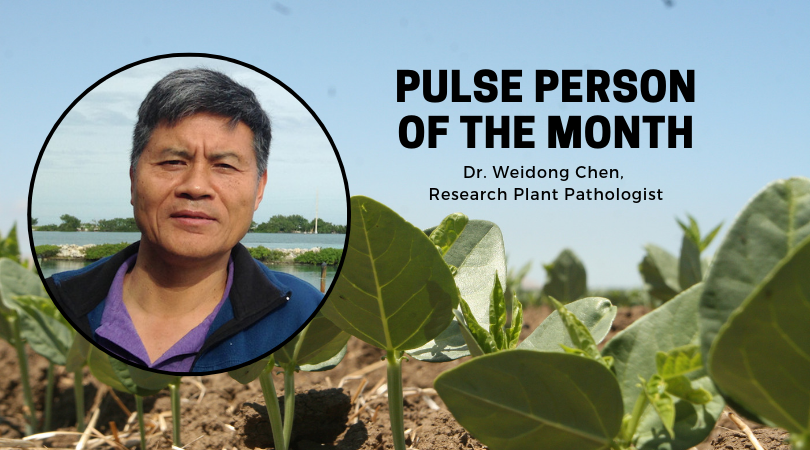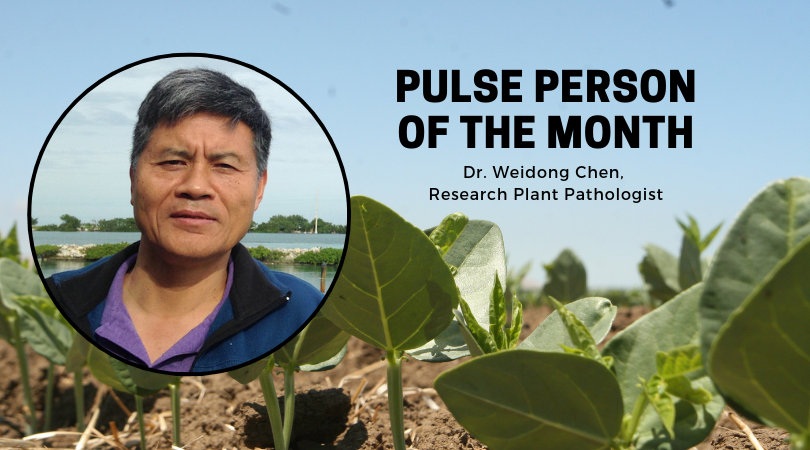
Each month, we highlight a researcher, farmer or other industry member who will share insights into pulse growing, marketing, research and more.
We sat down with Dr. Weidong Chen, a research plant pathologist at the USDA Agricultural Research Service in Pullman, Washington and an adjunct professor at Washington State University where he’s been teaching plant pathology since 2002. According to Dr. Chen, his job responsibilities include conducting research on fungal diseases of pulse crops, such as chickpeas, lentils and peas.
The Most Destructive Disease
Currently, Dr. Chen’s research includes Ascochyta blight of chickpeas and Sclerotinia white mold, which he says, “occurs on many crops including all legume crops” and metalaxyl-resistant Pythium, “which causes seed rot and damping-off.”
Ascochyta blights, Dr. Chen explains, are common diseases that occur with cool season legumes (chickpea, lentil, pea and faba beans). “The pathogens causing the diseases on these crops are host specific” he says.
A.fabae on faba bean, this diseases impacts above ground plants, affecting their stems, leaves, flowers, pods and seed, which start in small water-soaked spots that grow larger with time.
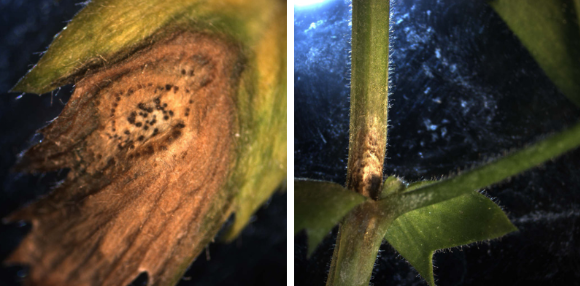
From Left: Ascochyta on a stem; Ascochyta Pods
Concurrently, there are four fungal species that may also cause this disease for peas. The names have recently changed, he says. “The fungal species names are Ascochyta pisi, Mycosphaerellapinodes, Phoma medicaginis var pinodella, and more recently found in Australia, Phomo koolunga. These species may occur alone or in combination with another in a single pea field.”
For the chickpea, Ascochyta blight (Phoma rabiei) is favored by high moisture and moderate low temperatures [15 – 25C], Dr. Chen reveals. It has been particularly destructive to these crops, as it’s common in almost all regions that produce chickpeas. It’s also the most important disease on chickpea in those areas and in other parts of the world. These aren’t new concerns either. “When [the] chickpea was first introduced into the United State Pacific Northwest in the early 1980’s,” he explains, “Ascochyta blight destroyed the crop in 1982 and 1983, promoting moratorium on chickpea production in the state of Idaho in 1984.”
In chickpeas, look for light brown to dark lesions with circular black dots, which bear hundreds of spores called conidia. In moist conditions, conidia spreads to neighboring plants, particularly from rain. As for the time of year this disease comes about, the pathogen can last through winter on infected debris that’s left on the ground, which can include seeds. “Ascochyta rabiei has two mating types and requires the presence of both mating types to reproduce ascospore sexually, but it can reproduce freely asexually by means of conidia. The sexual reproduction requires a moist and cool time provided by the winter conditions. Both mating types of Ascochyta rabiei are present in North America,” Dr. Chen explains.
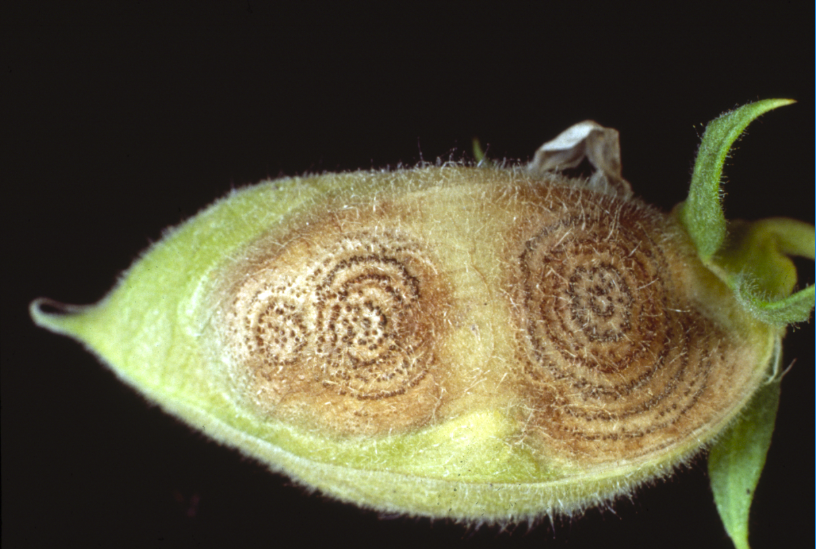
Photo Credit: Dr. Walter Kaiser, Plant Pathologist
Ascochyta Prevention
Crop rotation, seed treatment, planting more tolerant cultivars and fungicide application are among the prevention tips that Dr. Chen recommends. In other words, chickpea plants have no immunity to the disease, but some cultivars are more resistant to Ascochyta blight. This tolerance can be assisted with fungicide application.
Choose fields where chickpeas have not been produced or far away from those that have or are producing them. According to him, when chickpeas are planted in a field where there hasn’t been production in previous years, “there are only two sources of inoculum, ascospores from adjacent fields where chickpea was a crop in the previous year or inoculum on the seeds.”
After chickpeas are planted, the only preventative measure is to use fungicide spray to reduce disease.
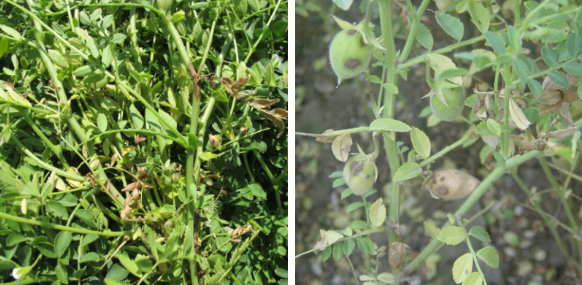
From Left: Ascochyta on a stef; Ascochyta pods
Washington Pest Outlook
While Ascochyta blight was the topic of today’s blog post, we asked Dr. Chen if there were any arising pest problems in Washington. A recent disease “is the emerging population of Pythium that became resistant to fungicide metalaxyl.” Dr. Chen says it has rendered fungicide metalaxyl ineffective.
Get the Facts on Pest Management
As we’re heard from researchers before, if you see something, say something. Dr. Chen’s advice to any grower managing pest problems:
- Seek university or county extension scientists for information on production and pest management.
- Contact plant disease diagnostic clinics in order to properly identify diseases.
- Talk it out – join our exclusive pulse industry group on Facebook to talk with researchers and growers to see what pest management tips they have to share!
He recommends the books: Compendium of Pea Diseases and Pests and Compendium of Chickpea and Lentil Diseases and Pests, both are available from APS Press.
Thank you, Dr. Chen, for being a Pulse Person of the Month!
If you would like to nominate next month’s Pulse Person, reach out to us on social media and tell us what you’d like to talk about. Connect with others in your pulse community and across state lines by sharing this post and joining our network on social media! Follow us on Twitter, like us on Facebook and join our exclusive pulse industry group, also on Facebook. We can’t wait to keep the conversation going.
